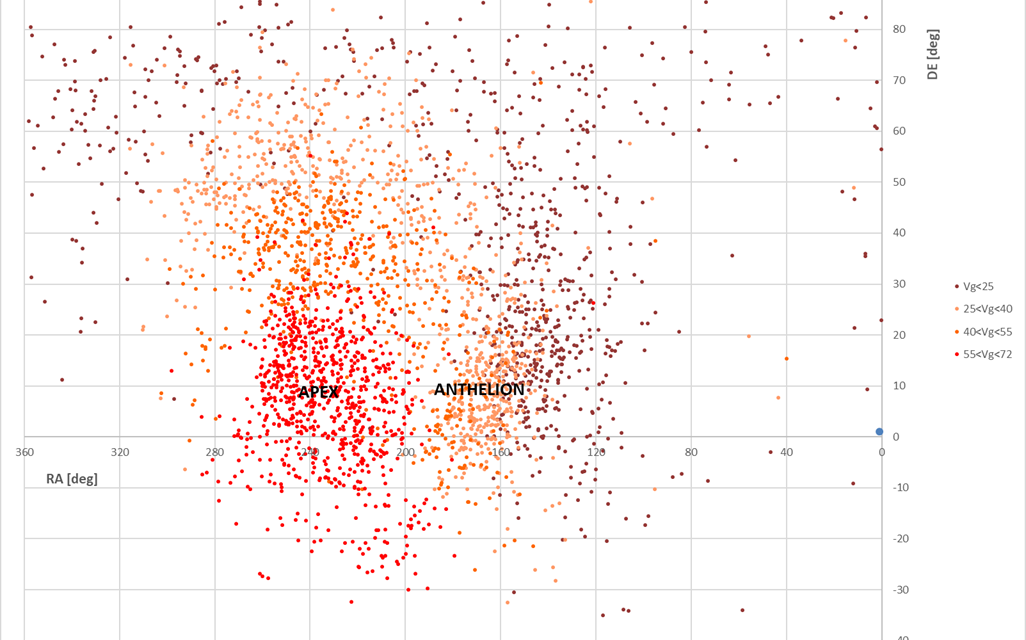A summary is presented of the results obtained by CAMS BeNelux during the months of February and March 2019.
1 February 2019
The last day of the month was the turning point to a very volatile period, which we would still experience further in March.
February 2019 was more or less a month with two faces. In the first decade, most stations were only able to work almost cloudless on one night. After this period it got much better again. The nights of 14–15 and 15–16 February resulted each in more than 300 multiple station meteors. After a short dip a period with beautiful spring weather during the day and very transparent clear nights at night followed in the period 22–27 February.
Only 4 nights went completely without any orbits: 4–5, 6–7, 9–10 and the last night of the month. Fifteen nights had more than 100 orbits, the absolute toppers being the aforementioned nights in the middle of the month. A total of 3485 orbits were recorded this month (see Figure 1)

Assuming that this year the period with the really clear nights almost coincided with the Full Moon period, this is a very good result. No major showers are active in February and the sporadic activity is clearly less than it used to be the months before.


In 2018, CAMS California, LO-CAMS and CAMS BeNeLux registered activity from around 13 February from a region near RA ~ 124 degrees and Decl. ~ +1 degree, in the border region of the constellations Canis Minor and Hydra. The night of 13–14 February was largely clear for all posts in the BeNeLux. However, no activity was observed from this region at the same solar longitude this year.
Figure 3 shows radiant positions of the meteors that were captured by the various networks in 2018, as well as what CAMS BeNeLux recorded in this year.
2 March 2019
A total of 1217 orbits were recorded in March. Especially in the first decade it was mostly cloudy, so that in that period less than 100 orbits could be registered.
The monthly score was nevertheless hardly lower than the best March score so far in our network: 1280 orbits in March 2018.
From this kind of numbers, it appears that the meteor activity in March is really at the annual dip.
Perhaps partly due to the mostly cloudy weather our network could not provide confirmation for an observation of increased activity from Bootes (571 TSB) in the night of 4–5 March 2019 (report P. Jenniskens via email).
Acknowledgment
Finally, many thanks to all the people who keep our network up and running!
Hans Betlem (Leiden-NL, CAMS 371 – 373), Felix Bettonvil (Utrecht-NL, CAMS 376–377), Jean-Marie Biets (Wilderen-B, CAMS 380 – 382), Martin Breukers (Hengelo-NL, CAMS 320 – 329), Bart Dessoy (Zoersel-B, CAMS 397, 398, 804 – 806 and 888), Jean-Paul Dumoulin / Christian Wanlin (Grapfontaine-B, CAMS 814 , 815), Luc Gobin (Mechelen-B, CAMS 390, 391, 807 and 808), Robert Haas (Alphen aan de Rijn-NL, CAMS 3160 – 3167), Robert Haas / Edwin van Dijk (Burlage-D, CAMS 801, 802, 821 and 822), Tioga Gulon (Nancy-FR, CAMS 3900) , Robert Haas (Texel-NL, CAMS 810 – 813), Klaas Jobse (Oostkapelle-NL, CAMS 3030 – 3037), Carl Johannink (Gronau-D, CAMS 311 – 318), Hervé Lamy (Ukkel-B, CAMS 393; Dourbes-B, CAMS 394 and 395), Koen Miskotte (Ermelo-NL, CAMS 351 – 354) , Jos Nijland (Terschelling-NL, CAMS 841 – 844), Tim Polfliet (Gent-B, CAMS 396), Steve Rau (Zillebeke-B, CAMS 3850 and 3852), Paul Roggemans (Mechelen-B, CAMS 383, 384, 388, 389, 399 and 809), Hans Schremmer (Niederkrüchten-D, CAMS 803), Erwin van Ballegoij (Heesh-NL, CAMS 347 and 348) and Marco van der Weide (Losser-NL, CAMS 3110).
References
Jenniskens P., Gural P. S., Grigsby B., Dynneson L., Koop M. and Holman D. (2011). “CAMS: Cameras for Allsky Meteor Surveillance to validate minor meteor showers”. Icarus, 216, 40–61.
Jenniskens P., Johannink C. and Moskovitz N. (2018). “February Hydrids outburst (IAU#1032, FHY)”. WGN, Journal of the International Meteor Organization, 46, 85–86.


